The new
"Circlorama" cinema in London
|
Read more
at in70mm.com The 70mm Newsletter |
| Written by: H. Jensen, Kino-Technik Nr. 7/1963. Compiled by: Thomas Hauerslev | Date: July 14, 2004 |
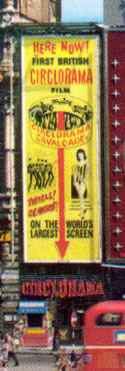 A new cinema
called "Circlorama" opened in the beginning of May. The audience is is surrounded
by a circular screen. The "Circlorama" process was developed by
the Russian professor E. Goldovsky, Moscow Cinema Research Institute. This
London cinema is built between Shaftsbury Avenue and Denham Street and it
opened May 9, 1963. The circular auditoria measures 18 meters in diameter
and has a height of 15 meters. There is room for 500 spectators. The foyer
is downstairs with room for a 1000 people. A new cinema
called "Circlorama" opened in the beginning of May. The audience is is surrounded
by a circular screen. The "Circlorama" process was developed by
the Russian professor E. Goldovsky, Moscow Cinema Research Institute. This
London cinema is built between Shaftsbury Avenue and Denham Street and it
opened May 9, 1963. The circular auditoria measures 18 meters in diameter
and has a height of 15 meters. There is room for 500 spectators. The foyer
is downstairs with room for a 1000 people.The screen surrounds the audience and has a total length of 45 meters. The lower edge of the screen is raised 2½ meters above the floor. 11 Philips FP20S projectors, which are arranged in a gallery around the auditoria, are projecting their pictures on 1/11 per circular projection screen. The 9-channel sound is played from a separate 35mm Philips sound reproducer. The projectors and sound reproducer are electronically synchronized through a interlock system. For sound reproduction 51 separate speakers have been installed behind the screen and in the floor. The entire installation can be remotely controlled from one control unit. For this installation the Philips projector FP20S have been equipped with gas pulsed light type SPP 800. This type of light offer s a constant and flicker free light and does not require adjusting like carbon arcs. The Russian title "Russian Roundabout" is filmed with a special rig consisting of 11 cameras which covers the complete circle. The films contains panoramic pictures from Moscow, 2000 horse riding Cossacks and speedboats. A second film is in production. The idea for this process is not new. A similar process was presented five years ago during the Brussels world expo in 1958 by The Walt Disney Company and the Ford Motor Company. That version was presented using 11 16mm projectors, where "Circlorama" is using 35mm film and professional 35mm projectors. The result is by far more realistic. There are 20 shows daily. Each performance last 20 minutes and ticket price is DM 2 for adults and DM 1,40 for children. There are no seats, the audience is standing in the middle of the auditoria and can watch the film from all sides. |
Further
in 70mm reading: Memories of Circlorama CircleVision 360 Kinopanorama Internet link: History of Panoramas New Musical Express January 1964: Blue Jeans Film for Circlorama Opening of circular Kinoranorama in Moscow Format: 11 x 4-35 360° |
Notes found on the internet |
|
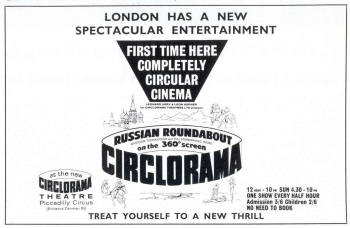 Press
picture to see enlargement Press
picture to see enlargement1958 wurde in England ein Verfahren vorgestellt, das - ähnlich dem Disney-Verfahren Circle-Vision sowie dem russischen Circorama-Format - mit elf 35mm-Projektoren ein Vollpanorama projizierte. Dabei wurde jeweils die Bildhöhe von vier Perforationslöchern ausgenutzt. 1964 wurde das Verfahren im Londoner Krogorama-Kino eingesetzt und nennt sich darum gelegentlich auch Krogorama. (JH) Here is the rough translation of the German notes into English as done by bablefish.altavista.com: "1958 were introduced in England a procedure, which - similarly the Disney procedure Circle vision as well as the Russian Circorama format - projected a full panorama with eleven 35mm-Projektoren. The image height of four perforation holes was used in each case. 1964 were used the procedure in the Londoner Krogorama cinema and call themselves therefore occasionally also Krogorama." 28 december 1963 Cinema-in-the-round shown at Piccadilly Circus, London under the name "Russian Roundabout" |
|
Reader comments |
|
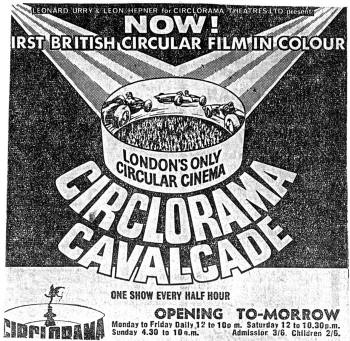 Press
picture to see enlargement Press
picture to see enlargementI used the FP20 in London in 1963. We ran 11 of them in a circular arrangement (called Circlorama). The projectors were first rate and never missed a beat. The pulsed light system worked well enough but was very high on maintenance and cost. Basically the lamp pulsed on and off and did away with the need for a shutter. The lamps were water cooled and the plumbing for eleven projectors got a bit complex:-) The Xenon lamp with it's simpler maintenance and much better light output killed it off eventually. But it was a very interesting concept. Jim Robertson 06.09.2001 Happy to oblige. Just give me an idea about the length of article you are looking for and any particular format required and I'll try to cobble something to-gether:). Incidentally we're going back to 1963-64. Life magazine (now defunct) did a shoot there. I remember the photographer (Larry Burrows, later killed in Vietnam) taking photos through a hole in the roof with a fish-eye lens. The photos may be in an archive somewhere. When I emigrated [Australia] here I became a professional sound recordist but loved my years as a projectionist and it's great to have a site like yours and Film-Tech to keep up to date. Unfortunately I never got to run 70mm. but it must be a blast. I recently saw Lawrence of Arabia in 70mm. and it looked superb. Regards Jim 14.07.2004 James Robertson in Australia worked at the Circlorama, hopefully will see your post. There’s also a good article in one of the old magazines of The Projected Picture Trust, who might be worth contacting. I did see myself Circlorama at Piccadilly, and cannot say I was that over impressed due to the large black gaps between the screens. The best circular screen process I’ve seen was at Disney’s Epcot, which I think, was The Canadian Experience, using 9 projectors. Just out of historical interest, when Circlorama folded it was replaced with a single screen News & Cartoon Cinema. The equipment was a pair of clapped out Simplex projectors onto RCA 1041 soundheads, which two years later were replaced with Philips FP 20s when renamed the Classic Cinema showing feature films. Easy Rider (1969) ran for over 9 months to packed houses. Bernard Tonks 14.07.2004 |
|
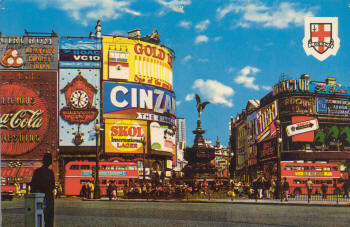 Contemporary postcard. Editors collection. Press
picture to see an
enlargement. Contemporary postcard. Editors collection. Press
picture to see an
enlargement.The film "Russian Roundabout" was filmed with the Soviet Circular Kinopanorama rig but projected with non-Soviet projectors. There had been a LOT of confusion of whether the film "Russian Roundabout" is the same as "Circlorama Calvalcade". I tend to think that Circlorama Calvalcade was a second film that premiered later, but I have not found anything yet to confirm this or who produced it. I'll try to see what else I can dig up. Dan Scherlock 14.07.2004 I remember seeing this Circlorama film on Central Pier in Blackpool, Lancashire, circa 1964. The film featured "The Swinging Blue Jeans" and parts of "Russian Roundabout" also. At the time it was a great novelty but was short lived. David Slack 16 August 2004 |
|
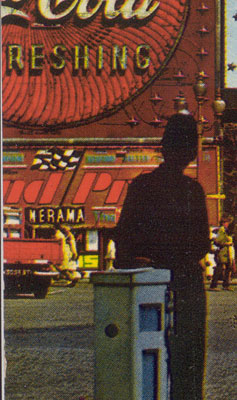 Note
giant advert for "Grand Prix" in Cinerama. The film was
premiered at the Casino
Cinerama theatre. Note
giant advert for "Grand Prix" in Cinerama. The film was
premiered at the Casino
Cinerama theatre.Comment on 'Circlorama' Dan Scherlock asks about "Circlorama Cavalcade". I remember Circlorama well, having been three times, initially to the excellent "Russian Roundabout" and latterly to the British "Circlorama Cavalcade". For the latter version, the FP20s used for the 35mm version had been replaced by 16mm machines. These must have been harder on the film, because from time to time one or other of the screens turned black for a while, presumably because a damaged part had been replaced by spacing, in order to keep everything in synch. This, combined with the soft 16mm print, compared very unfavourably with the immaculate 35mm version, as did the tedious and woeful British - made film itself. There was a pop group sequence, obviously not shot on eleven cameras simultaneously. We were treated to a 'Miss Circlorama' competition shot in an empty and rather dim Cafe Royal, this time with all the cameras in use. We could discern this because many of the wall mirrors sported tablecloths to cut down reflections. The ultimate nadir was achieved when 'doors' in the screens opened to permit a series of gangster-type machine-gun battles, all shot on one camera. What had been an enjoyable and interesting experience, with the potential for better things, had become a cheap (well, three shillings and sixpence, about seventeen and a half pence) fairground attraction. Not long later, the staff turned up for work to find a note pinned to the door. This advised them that the cinema was now closed, that they were now unemployed and that they should all report to the nearby Colquhoun Street Labour Exchange. very best wishes - Andrew Ward 16 May 2005 |
|
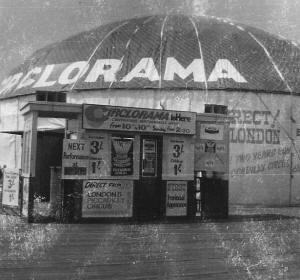 Photograph taken on Blackpool Central pier, July 1965. Image from Ray
Downing.
Press
image for enlargement Photograph taken on Blackpool Central pier, July 1965. Image from Ray
Downing.
Press
image for enlargementI worked on the projection side of Circlorama, when it was under canvas, on the central pier at Blackpool in 1965. The general manager was a Bolton showman called Bernard Woolley, a great friend, who had previously been responsible for booking top artists at major seaside venues on the north west coast, and took the occasional wrestling bouts to the continent, whilst still booking artists for shows and Granada TV. As previously stated by your subscribers, the 16mm. projectors were water cooled, and were fine, except for the unexpected problem you get at the seaside, which is fine sand. It managed to get into the water tanks no matter what you did. You could reduce the problem, but not eliminate it. The result was that, with eleven projectors working in synchronisation to give the impression of a circular screen, the sand would find it's way into a projector, blocking up the water filter, which automatically turned off the projector, which in turn made a section of the screen blank. Many's the time people complained, which eventually led to Bernard going missing at the end of the twenty minute shows, for which people had paid 3/6p. in old money (about 17.1/2p. now), quite a lot for only 20 minutes in those days. From Blackpool, the show went into the Kelvin Hall complex in Glasgow for Christmas season of 65. After a few weeks it became apparent that business was not covering the costs, and so it had to close. Just before it did, I was lucky enough to get another position at Elstree Studios, in Hertfordshire, but 1965 will always remain as having been one of the happiest periods of my life. Ray Downing 28 May 2005 |
|
|
Go: back
- top - back issues
- news index Updated 21-01-24 |
|
